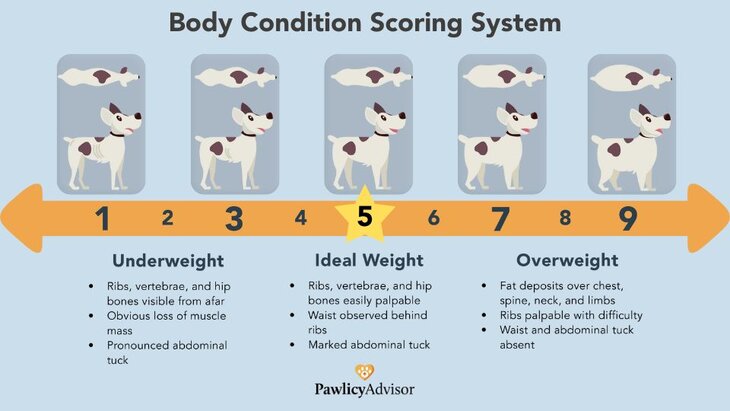Puppy Weight Calculator: How Big Will My Puppy Get?
Having a puppy is an exciting and heartwarming experience. However, we can’t help but wonder about how large our puppy will be as an adult.
Is my puppy still growing? How much bigger will my puppy get? Are they overweight or underweight?
Your new puppy may be small — but their vet bills won't be.
Save big on costs with pet insurance, so you can protect your puppy while protecting your wallet.
All of these are common questions that pet parents ask me in the vet office, and having a general idea of how big a puppy will get can provide you with insight into how much space you’ll need to put aside for their crate, dog bed, and more.
Today, we’re going to discuss factors that impact puppy growth, how to tell if your puppy is growing at a healthy rate, plus everything else you should know about puppy growth and development. We’ve included a puppy weight calculator to help you predict the approximate size of your dog at maturity.
Table of Contents:
- Estimate Your Dog's Size with our Puppy Growth Calculator
- How to Calculate a Puppy's Weight
- How to Tell How Big a Puppy Will Get
- Factors that Impact Puppy Growth and Development
- Causes for Stunted Growth in Puppies
- When do Puppies Grow the Most?
- When do Dogs Stop Growing?
- Is my Puppy Overweight?
- Health Risks Associated with Excess Weight
- Find the Puppy Growth Chart for Your Pet's Breed!
Estimate Your Dog's Size with our Puppy Growth Calculator
How to Calculate a Puppy's Weight
To help you estimate your puppy’s full-grown weight, we’ve built a Puppy Size Calculator. Simply select your dog’s breed and input their age in months and weight in pounds to predict their future growth. If your dog is a mixed breed, please select the appropriate size for your puppy.
Please note that all puppies grow at different rates and that these numbers are estimates to give you an idea of the maximum weight gain expected for your puppy given their breed size category.
Above all else, it’s essential that our puppies are healthy and happy. If you have concerns about your puppy’s growth and development, please consult with your veterinarian for further information.

How to Tell How Big a Puppy Will Get
In addition to using our puppy weight estimate calculator, there are several ways to predict your puppy's full-grown size, including their breed, genetics, and physical characteristics.
Breed Standards
First, start with your puppy’s breed. If your puppy is a purebred dog, such as a Labrador Retriever or Siberian Husky, the American Kennel Club standards for their breed can give you a specific range for their expected weight and height.
If your puppy is a mixed breed, it may be easier to estimate their adult size based on their parents and previous litters. If you know how much your puppy’s parents weigh, that will give you a rough idea of the largest your puppy could grow to be. A puppy will rarely grow to be larger than its biggest parent, so this provides a ceiling for your puppy’s adult size.
Genetics
Knowing about the size of litters in the past is another way to estimate your puppy’s adult size. For example, If previous litters weighed between 15 to 20 pounds on average, your pup will likely fall within that range or close to it.
Physical Traits
Lastly, take a look at your puppy’s paws. Oversized paws are a classic adolescent feature. If your puppy’s paws look overly large next to their legs and body, they are likely still growing!
Use a Puppy Growth Chart
Find your pet's breed in the list below to track your puppy''s growth month by month.
- Akita Growth & Weight Chart
- Alaskan Malamute Growth & Weight Chart
- Australian Shepherd Growth & Weight Chart
- Basset Hound Growth & Weight Chart
- Beagle Growth & Weight Chart
- Bernese Mountain Dog Growth & Weight Chart
- Blue Heeler Growth & Weight Chart
- Boerboel Growth & Weight Chart
- Border Collie Growth & Weight Chart
- Boxer Growth & Weight Chart
- Cane Corso Growth & Weight Chart
- Cavalier King Charles Spaniel Growth & Weight Chart
- Chihuahua Growth & Weight Chart
- Chow Chow Growth & Weight Chart
- Corgi Growth & Weight Chart
- Dachshund Growth & Weight Chart
- Doberman Pinscher Growth & Weight Chart
- English Bulldog Growth & Weight Chart
- English Mastiff Size Guide: Growth Chart
- French Bulldog Growth & Weight Chart
- German Shepherd Growth & Weight Chart
- Golden Retriever Growth & Weight Chart
- Great Dane Growth & Weight Chart
- Great Pyrenees Growth & Weight Chart
- Greyhound Growth & Weight Chart
- Havanese Growth & Weight Chart
- Irish Wolfhound Growth & Weight Chart
- Jack Russell Terrier Growth & Weight Chart
- Labradoodle Growth & Weight Chart
- Labrador Retriever Growth & Weight Chart
- Maltese Growth & Weight Chart
- Newfoundland Growth & Weight Chart
- Pitbull Growth & Weight Chart
- Pomeranian Growth & Weight Chart
- Poodle Growth & Weight Chart
- Pug Growth & Weight Chart
- Rhodesian Ridgeback Growth & Weight Chart
- Rottweiler Growth & Weight Chart
- Samoyed Growth & Weight Chart
- Siberian Husky Growth & Weight Chart
- Shiba Inu Growth & Weight Chart
- Shih Tzu Growth & Weight Chart
- St. Bernard Growth & Weight Chart
- Tibetan Mastiff Growth & Weight Chart
Factors that Impact Puppy Growth and Development
A number of factors, such as gender, diet, exercise, and health, can impact your puppy's growth and development, causing it to deviate from its expected size.
Gender
In many cases, male dogs will be larger than female dogs of the same breed. This tends to be true in terms of both height and weight.
Keep in mind that this is not always the case. Some females will grow larger than their male counterparts, and some dog breeds — especially ones smaller in size — will have minimal weight variations between the genders. However, as a general rule, male dogs tend to be larger than female dogs.
Diet
Nutrition is another crucial factor that affects your puppy’s growth and overall health. According to the Veterinary Centers of America, an optimal growth rate in puppies is steady and slow. An optimal growth rate helps your pup to avoid putting on excess weight.
Comparatively, a maximal growth rate indicates that your puppy is growing as quickly as possible, which can lead to skeletal deformities, hip dysplasia, obesity, and a shorter life span. A maximal growth rate typically occurs when puppies are overfed or given fatty foods.
Exercise
Overexercising your puppy can also impact their growth. Your puppy’s bones are still growing and are softer, making them more prone to breakage or suffering from skeletal trauma. The Veterinary Centers of America recommends that puppies are limited to short spurts of exercise where they can set their own pace, rather than being taken on long runs or put through intense training.
Causes for Stunted Growth in Puppies
One of the most common causes of stunted growth in puppies is hookworms or roundworms, both of which parasites are prevalent in puppies in the United States. Worms can be contracted from either the puppy’s mother or the environment around them.
When a puppy has worms, they are at risk of the parasite siphoning calories which can slow the puppy’s growth. Typically, once a puppy is free from the worms, it can recover and continue growing at a healthy rate.
Your veterinarian is your best resource for personalized nutrition and exercise advice. Learn how you can save money on vet visits here.
Does Neutering Stunt Growth?
No, neutering does not stunt growth.
On the contrary, recent research shows that spaying and neutering can actually delay the closing of the bone growth palettes, which can cause a dog or cat to grow taller than they would have previously. This increased growth may affect how joints align, which is concerning to researchers and veterinarians.
At this time, we do not know when this growth effect ends, which is why many orthopedic surgeons are recommending that pet parents wait until their pet has reached skeletal maturity before they spay or neuter their animal.
This information is especially important for pet parents with pets predisposed to orthopedic disease, which many large dog breeds are more prone to. Most veterinarians will wait to spay and neuter dogs until they are at least six months old, if not older, to decrease the risk of overgrowth and joint problems.
When do Puppies Grow the Most?
All puppies are unique and grow at their own rate. Unfortunately, there is no easy answer as to when your puppy will grow the most — especially if they are a mixed breed because they’re more prone to variation in their final size than purebreds. Generally, puppies experience the most dramatic growth during the first six months of their life, with a notable decrease in growth rate between six to twelve months.
Smaller dog breeds may already be finished growing by six to eight months, but large dogs will continue to grow steadily after six months until they’ve reached their final size. One research study found that smaller dogs grow 13 to 17% of their body weight per week during the first 12 months of their lives, compared to the first 18 months in larger and giant dog breeds.

When do Dogs Stop Growing?
All puppies are considered adults after they are a year old. However, puppies will finish growing at different ages based on their breed.
You can expect your puppy to go through their most dramatic growth spurts during the first six months of their life. If your puppy is a larger breed, it will likely continue growing substantially for at least another six months.
When do Small Dogs Stop Growing?
Smaller dogs need less time to fill out and take about half the time to finish growing compared to larger dogs. Many small dogs, such as Chihuahuas, will stop growing before they are a year old. According to the American Kennel Club, small dog breeds are nearly finished growing by the time they are six to eight months old. A study from The Journal of Nutrition found that toy, small, and medium-sized dog breeds reached their adult weight at nine to 10 months of age on average. If you have a toy, small, or medium dog, you can expect them to stop growing before their first birthday.
When do Large Dogs Stop Growing?
Although they may be considered “adults” at one-year-old, large and giant dogs typically need more than 12 months to finish growing. A study from The Journal of Nutrition found that large and giant dog breeds typically reached their adult size between 11 to 15 months old on average.
Is my Puppy Overweight?
When our puppies undergo massive changes in their weight and height, it can be challenging to gauge if they are putting on a healthy amount of weight or excess weight. The following body condition score chart is a standard system that you can use to assess your puppy’s weight.

If your dog has a score of 5, they are at an ideal weight. You should be able to easily feel their ribs underneath a thin layer of fat, and they should have a defined waist. If your pup is not at a 5, speak with your veterinarian today about your pet’s health and what steps you can do to help them achieve an ideal weight.
How to Tell if My Dog is Fat
55.8% of dogs in the United States are considered overweight or obese. If you suspect your dog may be carrying some extra weight, you’re not alone. Take a moment today and assess your dog’s current state using the body condition chart above.
Besides the body condition score, there are a handful of other ways to tell if your dog is fat.
Your dog may be overweight if:
- You cannot easily feel their ribs due to a thick layer of fat. If you cannot feel their ribs without significant pressure, they may be overweight.
- Your dog has excess fat deposits on their lower back, legs, hips, or tail.
- They have a sagging waist or stomach when you view them from the side.
- Your dog has become a couch potato and has little energy.
- They struggle to walk or cannot breathe easily while walking.
If you believe your dog is overweight, reach out to your veterinarian. With their help, you can develop a plan to help your dog safely lose excess weight.
How to Tell if my Dog is Underweight
We often think about extra weight as dangerous to our pets’ health, but being underweight presents many health risks to our beloved dogs as well.
Your dog may be underweight if:
- You can easily feel your dog’s ribs, and their ribs protrude from their skin due to a lack of fat between the ribs and skin.
- The ribs and spine are clearly visible when viewed from above.
- Your dog is constantly hungry and “inhales” their food. (This may be a sign that you need to adjust their food intake. Always discuss this with your veterinarian first.)
- You can easily feel your dog’s shoulder bones, hip bones, and spinal cord.
If you suspect your dog is underweight, reach out to your veterinarian. From there, they can assess your dog’s current state and suggest healthy lifestyle changes to help your pup gain weight healthily.
Health Risks Associated with Excess Weight
Like humans, dogs are at an increased risk of health problems when they carry excess weight. 18.9% of dogs in the United States are obese, meaning they are excessively overweight, and over half of the dogs in America are overweight. The number of overweight pets is on the rise, which unfortunately presents a considerable threat to our pets’ health and well-being.
According to the American Kennel Club, being just 10% overweight decreases our pup’s lifespan by a third and makes them more susceptible to diabetes, arthritis, kidney and liver disorders, cancer, and heart disease. Excess weight not only threatens our dog’s lifespan but their overall enjoyment and quality of life.
Final Thoughts
While we can’t control how susceptible our dog may be to specific diseases and genetic conditions, we can help them live a healthy lifestyle and take them to their veterinarian for regular preventative care.
Your veterinarian is your ultimate resource when it comes to recognizing if your dog is at a healthy weight, screening them for possible health problems, and providing you with personalized recommendations to keep your dog as healthy and happy as possible. Routine veterinary care is the biggest step that we, as loving pet parents, can take to protect our beloved dogs against the dangers of excess weight and disease.
Unfortunately, veterinary care can quickly become expensive. When surveyed, only 1 in 5 pet parents said they’d be able to cover a $5,000 veterinary expense out-of-pocket. This leaves many pet parents in a precarious position if their pet is ever injured or develops an illness.
Pet insurance provides financial assistance for situations like these by reimbursing you for up to 100% of out-of-pocket veterinary costs, so you can provide your pup with the best care possible.
Not only does pet insurance provide you with a safety net should something occur, such as Parvo in puppies and accidental injuries, but wellness plans are also available to help with the cost of preventive care.
Preventative care plays a critical role in both preventing disease and improving your pet’s everyday quality of life. Wellness plans can help with the cost of vaccinations, dental cleanings, heartworm tests, routine veterinary exams, and more.
Give yourself peace of mind today by signing up for a pet insurance plan today. Pawlicy Advisor can help you compare compare pet insurance options and provides personalized recommendations to help you maximize savings.
Some people can predict the future.
For everyone else, there's pet insurance.
Looking to save on vet bills? See which pet insurance is right for you.
Instant results. 1M+ pet parents served.
⭐⭐⭐⭐⭐ 4.9 stars across hundreds of reviews.
Do you want to find the best pet insurance?
Let's analyze your pet's breed, age, and location to find the right coverage and the best savings. Ready?
Analyze My PetAbout Pawlicy Advisor
The pet insurance marketplace endorsed by veterinarians, at Pawlicy Advisor we make buying the best pet insurance easier. By comparing personalized coverage and pricing differences we can save you a ton of money, up to 83% in some instances!
Instantly Compare Pet Insurance Plans
Guides
Determine If Pet Insurance Is Worth It
Comparison Charts
Find Your State
Dog Insurance
DVM
Ricky Walther, DVM, is a small animal general practitioner in the greater Sacramento, California area. Realizing the positive financial and medical impact that pet insurance can provide for pet parents and the profession, he lends support and advice to companies like Pawlicy Advisor "The Pet Insurance Marketplace") that simplify the process of connecting with veterinary financing resources.
